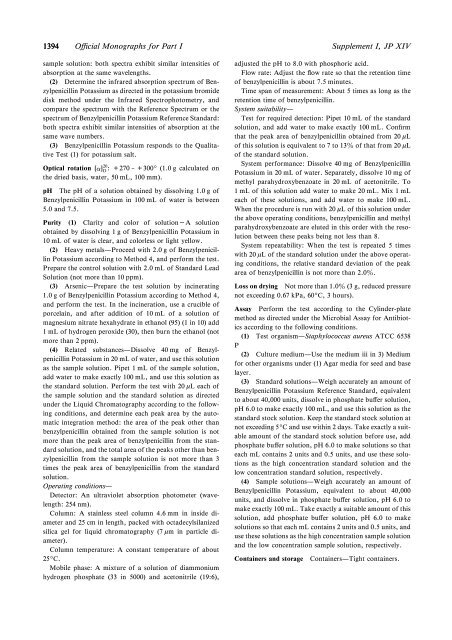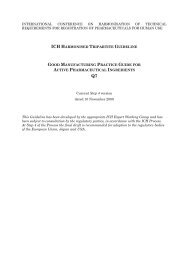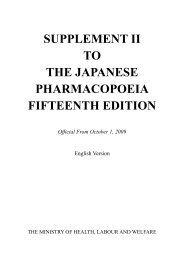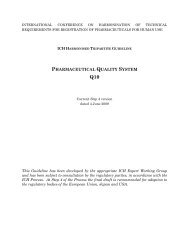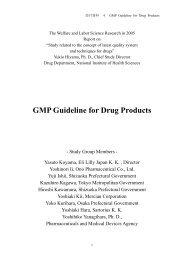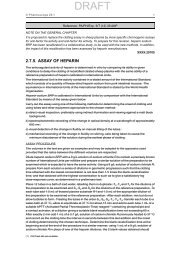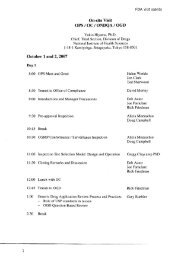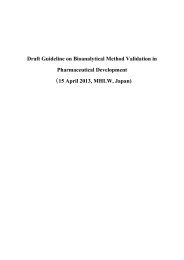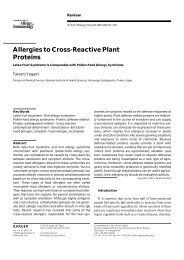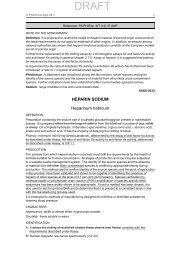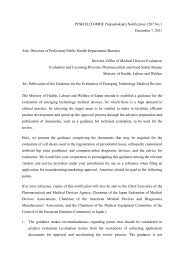Supplement I to the Japanese Pharmacopoeia Fourteenth Edition
Supplement I to the Japanese Pharmacopoeia Fourteenth Edition
Supplement I to the Japanese Pharmacopoeia Fourteenth Edition
You also want an ePaper? Increase the reach of your titles
YUMPU automatically turns print PDFs into web optimized ePapers that Google loves.
1394 O‹cial Monographs for Part I<br />
<strong>Supplement</strong> I, JP XIV<br />
sample solution: both spectra exhibit similar intensities of<br />
absorption at <strong>the</strong> same wavelengths.<br />
(2) Determine <strong>the</strong> infrared absorption spectrum of Benzylpenicillin<br />
Potassium as directed in <strong>the</strong> potassium bromide<br />
disk method under <strong>the</strong> Infrared Spectropho<strong>to</strong>metry, and<br />
compare <strong>the</strong> spectrum with <strong>the</strong> Reference Spectrum or <strong>the</strong><br />
spectrum of Benzylpenicillin Potassium Reference Standard:<br />
both spectra exhibit similar intensities of absorption at <strong>the</strong><br />
same wave numbers.<br />
(3) Benzylpenicillin Potassium responds <strong>to</strong> <strong>the</strong> Qualitative<br />
Test (1) for potassium salt.<br />
Optical rotation [a] 20<br />
D : +270 – +3009(1.0 g calculated on<br />
<strong>the</strong> dried basis, water, 50 mL, 100 mm).<br />
pH The pH of a solution obtained by dissolving 1.0 g of<br />
Benzylpenicillin Potassium in 100 mL of water is between<br />
5.0 and 7.5.<br />
Purity (1) Clarity and color of solution-A solution<br />
obtained by dissolving 1 g of Benzylpenicillin Potassium in<br />
10 mL of water is clear, and colorless or light yellow.<br />
(2) Heavy metals—Proceed with 2.0 g of Benzylpenicillin<br />
Potassium according <strong>to</strong> Method 4, and perform <strong>the</strong> test.<br />
Prepare <strong>the</strong> control solution with 2.0 mL of Standard Lead<br />
Solution (not more than 10 ppm).<br />
(3) Arsenic—Prepare <strong>the</strong> test solution by incinerating<br />
1.0 g of Benzylpenicillin Potassium according <strong>to</strong> Method 4,<br />
and perform <strong>the</strong> test. In <strong>the</strong> incineration, use a crucible of<br />
porcelain, and after addition of 10 mL of a solution of<br />
magnesium nitrate hexahydrate in ethanol (95) (1 in 10) add<br />
1 mL of hydrogen peroxide (30), <strong>the</strong>n burn <strong>the</strong> ethanol (not<br />
more than 2 ppm).<br />
(4) Related substances—Dissolve 40 mg of Benzylpenicillin<br />
Potassium in 20 mL of water, and use this solution<br />
as <strong>the</strong> sample solution. Pipet 1 mL of <strong>the</strong> sample solution,<br />
add water <strong>to</strong> make exactly 100 mL, and use this solution as<br />
<strong>the</strong> standard solution. Perform <strong>the</strong> test with 20 mL eachof<br />
<strong>the</strong> sample solution and <strong>the</strong> standard solution as directed<br />
under <strong>the</strong> Liquid Chroma<strong>to</strong>graphy according <strong>to</strong> <strong>the</strong> following<br />
conditions, and determine each peak area by <strong>the</strong> au<strong>to</strong>matic<br />
integration method: <strong>the</strong> area of <strong>the</strong> peak o<strong>the</strong>r than<br />
benzylpenicillin obtained from <strong>the</strong> sample solution is not<br />
more than <strong>the</strong> peak area of benzylpenicillin from <strong>the</strong> standard<br />
solution, and <strong>the</strong> <strong>to</strong>tal area of <strong>the</strong> peaks o<strong>the</strong>r than benzylpenicillin<br />
from <strong>the</strong> sample solution is not more than 3<br />
times <strong>the</strong> peak area of benzylpenicillin from <strong>the</strong> standard<br />
solution.<br />
Operating conditions—<br />
Detec<strong>to</strong>r: An ultraviolet absorption pho<strong>to</strong>meter (wavelength:<br />
254 nm).<br />
Column: A stainless steel column 4.6 mm in inside diameter<br />
and 25 cm in length, packed with octadecylsilanized<br />
silica gel for liquid chroma<strong>to</strong>graphy (7 mm in particle diameter).<br />
Column temperature: A constant temperature of about<br />
259C.<br />
Mobile phase: A mixture of a solution of diammonium<br />
hydrogen phosphate (33 in 5000) and ace<strong>to</strong>nitrile (19:6),<br />
adjusted <strong>the</strong> pH <strong>to</strong> 8.0 with phosphoric acid.<br />
Flow rate: Adjust <strong>the</strong> ‰ow rate so that <strong>the</strong> retention time<br />
of benzylpenicillin is about 7.5 minutes.<br />
Time span of measurement: About 5 times as long as <strong>the</strong><br />
retention time of benzylpenicillin.<br />
System suitability—<br />
Test for required detection: Pipet 10 mL of <strong>the</strong> standard<br />
solution, and add water <strong>to</strong> make exactly 100 mL. Conˆrm<br />
that <strong>the</strong> peak area of benzylpenicillin obtained from 20 mL<br />
of this solution is equivalent <strong>to</strong> 7 <strong>to</strong> 13z of that from 20 mL<br />
of <strong>the</strong> standard solution.<br />
System performance: Dissolve 40 mg of Benzylpenicillin<br />
Potassium in 20 mL of water. Separately, dissolve 10 mg of<br />
methyl parahydroxybenzoate in 20 mL of ace<strong>to</strong>nitrile. To<br />
1 mL of this solution add water <strong>to</strong> make 20 mL. Mix 1 mL<br />
each of <strong>the</strong>se solutions, and add water <strong>to</strong> make 100 mL.<br />
When <strong>the</strong> procedure is run with 20 mL ofthissolutionunder<br />
<strong>the</strong> above operating conditions, benzylpenicillin and methyl<br />
parahydroxybenzoate are eluted in this order with <strong>the</strong> resolution<br />
between <strong>the</strong>se peaks being not less than 8.<br />
System repeatability: When <strong>the</strong> test is repeated 5 times<br />
with 20 mL of <strong>the</strong> standard solution under <strong>the</strong> above operating<br />
conditions, <strong>the</strong> relative standard deviation of <strong>the</strong> peak<br />
area of benzylpenicillin is not more than 2.0z.<br />
Loss on drying Not more than 1.0z (3 g, reduced pressure<br />
not exceeding 0.67 kPa, 609C, 3 hours).<br />
Assay Perform <strong>the</strong> test according <strong>to</strong> <strong>the</strong> Cylinder-plate<br />
method as directed under <strong>the</strong> Microbial Assay for Antibiotics<br />
according <strong>to</strong> <strong>the</strong> following conditions.<br />
(1) Test organism—Staphylococcus aureus ATCC 6538<br />
P<br />
(2) Culture medium—Use <strong>the</strong> medium iii in 3) Medium<br />
for o<strong>the</strong>r organisms under (1) Agar media for seed and base<br />
layer.<br />
(3) Standard solutions—Weigh accurately an amount of<br />
Benzylpenicillin Potassium Reference Standard, equivalent<br />
<strong>to</strong> about 40,000 units, dissolve in phosphate buŠer solution,<br />
pH 6.0 <strong>to</strong> make exactly 100 mL, and use this solution as <strong>the</strong><br />
standard s<strong>to</strong>ck solution. Keep <strong>the</strong> standard s<strong>to</strong>ck solution at<br />
not exceeding 59C and use within 2 days. Take exactly a suitable<br />
amount of <strong>the</strong> standard s<strong>to</strong>ck solution before use, add<br />
phosphate buŠer solution, pH 6.0 <strong>to</strong> make solutions so that<br />
each mL contains 2 units and 0.5 units, and use <strong>the</strong>se solutions<br />
as <strong>the</strong> high concentration standard solution and <strong>the</strong><br />
low concentration standard solution, respectively.<br />
(4) Sample solutions—Weigh accurately an amount of<br />
Benzylpenicillin Potassium, equivalent <strong>to</strong> about 40,000<br />
units, and dissolve in phosphate buŠer solution, pH 6.0 <strong>to</strong><br />
make exactly 100 mL. Take exactly a suitable amount of this<br />
solution, add phosphate buŠer solution, pH 6.0 <strong>to</strong> make<br />
solutions so that each mL contains 2 units and 0.5 units, and<br />
use <strong>the</strong>se solutions as <strong>the</strong> high concentration sample solution<br />
and <strong>the</strong> low concentration sample solution, respectively.<br />
Containers and s<strong>to</strong>rage<br />
Containers—Tight containers.


